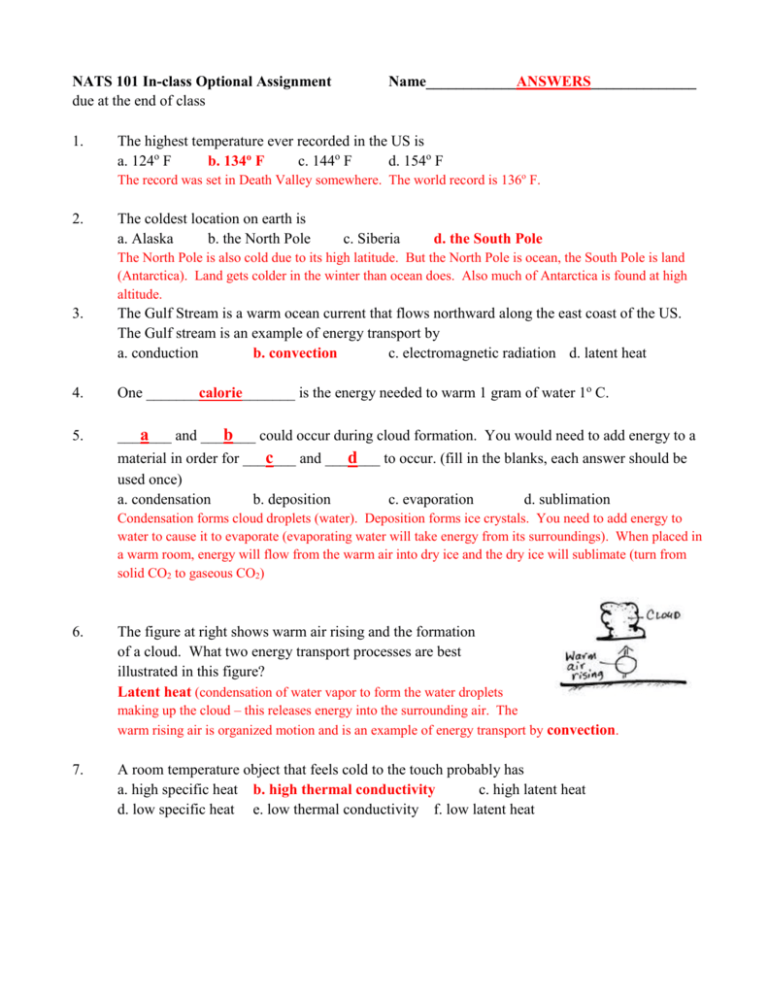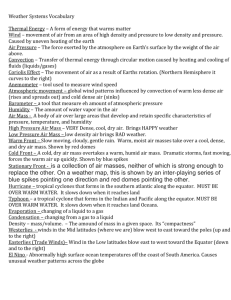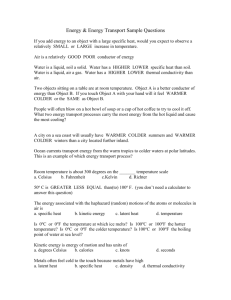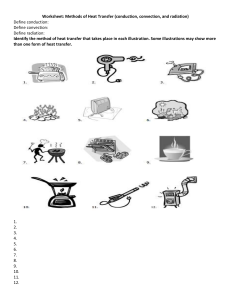feb23_inclass_answ
advertisement

NATS 101 In-class Optional Assignment due at the end of class 1. Name____________ANSWERS______________ The highest temperature ever recorded in the US is a. 124o F b. 134o F c. 144o F d. 154o F The record was set in Death Valley somewhere. The world record is 136o F. 2. The coldest location on earth is a. Alaska b. the North Pole c. Siberia d. the South Pole The North Pole is also cold due to its high latitude. But the North Pole is ocean, the South Pole is land (Antarctica). Land gets colder in the winter than ocean does. Also much of Antarctica is found at high altitude. 3. The Gulf Stream is a warm ocean current that flows northward along the east coast of the US. The Gulf stream is an example of energy transport by a. conduction b. convection c. electromagnetic radiation d. latent heat 4. One _______calorie_______ is the energy needed to warm 1 gram of water 1o C. 5. ___a___ and ___b___ could occur during cloud formation. You would need to add energy to a material in order for ___c___ and ___d___ to occur. (fill in the blanks, each answer should be used once) a. condensation b. deposition c. evaporation d. sublimation Condensation forms cloud droplets (water). Deposition forms ice crystals. You need to add energy to water to cause it to evaporate (evaporating water will take energy from its surroundings). When placed in a warm room, energy will flow from the warm air into dry ice and the dry ice will sublimate (turn from solid CO2 to gaseous CO2) 6. The figure at right shows warm air rising and the formation of a cloud. What two energy transport processes are best illustrated in this figure? Latent heat (condensation of water vapor to form the water droplets making up the cloud – this releases energy into the surrounding air. The warm rising air is organized motion and is an example of energy transport by convection. 7. A room temperature object that feels cold to the touch probably has a. high specific heat b. high thermal conductivity c. high latent heat d. low specific heat e. low thermal conductivity f. low latent heat 8. A person is standing outside on a cold windy day in Fig. A at right. The person has fallen into cold water in Fig. B. In Fig. C the person is perspiring heavily on a hot dry summer day. Match each of the energy transport processes below with the situation at right that best illustrates each process. latent heat__C___ conduction___B___ convection___A____ When people sweat, water on their bodies evaporates. That’s a phase change and that is why C is an example of latent heat transport. You might think B is an example of latent heat transport because water is involved. But there is no phase change. Water does have a higher thermal conductivity than air. You’ll feel cold in 70o F water even though70o F is comfortable because the water will conduct energy away from your warm body more rapidly than air. Wind is an example of forced convection. 9. Frost sometimes forms on cold mornings. Would frost release energy into and WARM the surrounding air or take energy from and COOL the surrounding air? Frost is example of deposition – a water vapor to ice phase change. Energy is released into the surrounding air and warms the air. 10. Why is electromagnetic radiation the most important of the 4 energy transport processes? EM radiation is the only way energy can be transported through empty space. Thus this is the only way the earth can receive energy from the sun.








